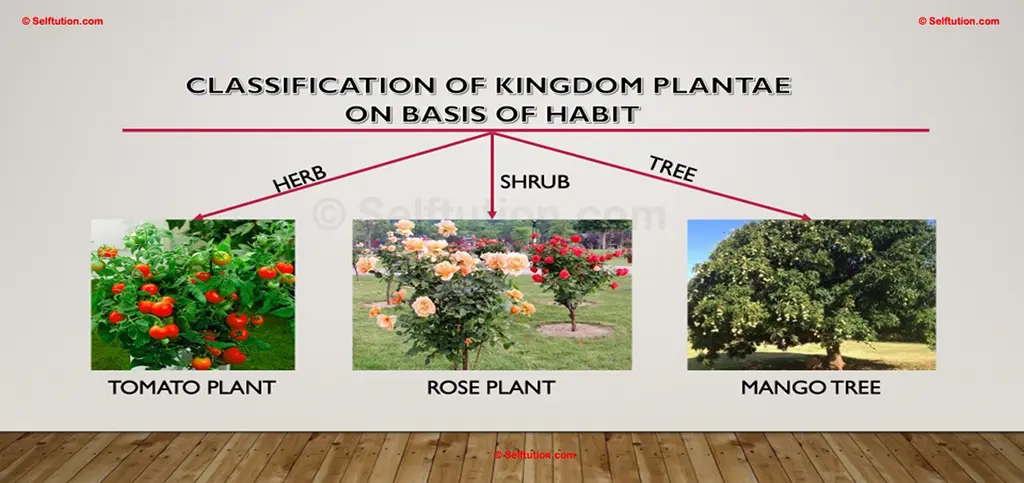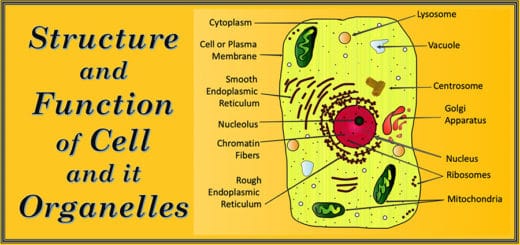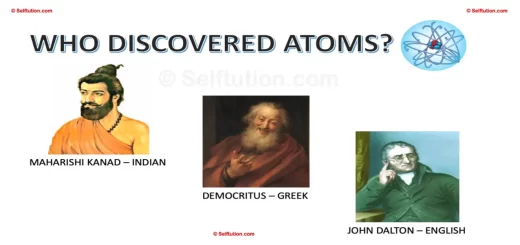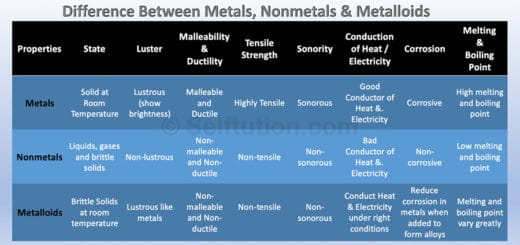Kingdom Plantae Examples, Classification and Characteristics
The classification of the plant kingdom, or the Kingdom Plantae, based on characteristics, along with examples, is as follows:
- Primary classification
- Flowering plants – Plants that bear flowers
- Angiosperms – mango, peas, apple, sugarcane, and grass.
- Gymnosperms – pine, fir, cedar, and spruce trees
- Non-flowering plants – Plants that do not bear flowers
- Algae – Chlamydomonas, and Spirogyra
- Bryophyta – mosses
- Pteridophyta – ferns
- Flowering plants – Plants that bear flowers
- Classification and examples of the plant kingdom based on habit
- Classification and examples of the kingdom Plantae based on lifecycle
- Classification and examples of the plant kingdom based on the mode of nutrition
- Autotrophs – plants that prepare their food – Most green-colored plants
- Heterotrophs – A Plant that does not prepare food
- Parasites – Cuscuta, and Viscum
- Saprophytes – yeast and fungi.
- Classification and examples of the kingdom Plantae based on habitat
- Mesophytes – mango, and apple
- Hydrophytes – Lotus, and water lilies
- Xerophytes – Cactus
Click here to download – Classification of the Kingdom Plantae with characteristics and examples
Topics Covered:
- Introduction
- Primary classification and examples of the plant kingdom
- Other classifications and examples of the Kingdom Plantae
INTRODUCTION
The Plant Kingdom, or the Kingdom Planta,e comprises 17% of the total species studied by mankind to date. In number, it comes out to be nearly 2,21,000. Isn’t it large? Interestingly, this number is only 15% of the total species of plants present on the planet Earth.
Plants exhibit great diversity in characteristics. Some of them are microscopic and invisible to the eyes, and then there are others as huge as a banyan tree. Due to their large number and varying characteristics, it is impossible to study them individually. So, to help, all members of the plant kingdom with similar characteristics are clubbed together to form groups. We call this process the classification of the plant kingdom or the kingdom Plantae. In this post, we will learn about the different bases used for classification in the Kingdom Plantae, along with examples and characteristics of each group. For classification of the animal kingdom, click here.
Click here to download – Classification of the Kingdom Plantae with characteristics and examples
PRIMARY CLASSIFICATION OF THE PLANT KINGDOM WITH EXAMPLES
Plants are useful to all of us. They provide us with useful products, for example – (i) cereals like wheat and, rice (ii) fruits like bananas, apples, and mangoes (iii) vegetables like potato, spinach, beans, and tomato (iv) sugar, tea, coffee (v) wood for our home (vi) medicines and numbers of other items. How have these large numbers of products become available to us? It is because there is a great variety of plant life on the planet Earth. They differ in habitat, types of plants, size, habit, duration of life cycles, mode of nutrition, and various other characteristics. Many plants have also developed special organs for performing special functions like climbing and protection.
We can classify the Kingdom Plantae in numerous ways, however, the most common one is the division into a group of non-flowering and flowering plants.
- Non-flowering plants do not bear flowers. Examples are Chlamydomonas, Spirogyra, mosses, and ferns.
- Flowering plants, as the name suggests, bear flowers. Examples are mango, rose, sunflower, sugarcane, grass, pine, fir, and cedar.

Classification and examples of the Kingdom Plantae or the Plant Kingdom – Flowering and nonflowering plants.
Due to the varying characteristics of flowering plants, they are further classified based on habit, duration of the life cycle, mode of nutrition, and habitat.
1.0 NON-FLOWERING PLANTS
Nonflowering plants have three classifications: Algae, Bryophyta, and Pteridophyta
ALGAE

Filamentous Algae

Algae in a pond
Algae are aquatic in habitat and found in both marine and freshwater environments. They are usually green and have chlorophyll. Mostly, they are found on the surface of the ponds where they get ample sunlight for preparing food. Algae may be single-celled or multicelled. Examples are – Chlamydomonas single-celled alga, and Spirogyra which is a multi-celled filament-shaped alga commonly found in ponds.
Click here to download – Classification of the Kingdom Plantae with characteristics and examples
BRYOPHYTA (MOSSES)

The green layer of mosses
Bryophyta, or mosses, grow as green, velvety layers in moist and shady places such as damp soil, on the bark of trees, and on damp walls. These plants have peculiar characteristics in that they have stems and leaves, but no roots. Instead, they have threadlike structures called rhizoids that stick to the surface and absorb water and minerals.
PTERIDOPHYTES (FERNS)

Ferns – Plants used for decoration
Pteridophytes, or ferns, are grown in most gardens for their beautiful leaves. They bear well-formed leaves, stems, and roots, but do not produce flowers and seeds. Their leaves produce small, rounded bodies on their undersurface. These bodies contain tiny spores, which are capable of producing plants. When leaves fall or these spores get scattered and reach the soil, they produce new plants. It is important to note that spores are not seeds.
Click here to download – Classification of the Kingdom Plantae with characteristics and examples
2.0 FLOWERING PLANTS
Flowering plants are also known as seed-bearing plants. They further have two classifications – Gymnosperms and Angiosperms.
GYMNOSPERMS
The Gymnosperms are a group of plants that bear seeds, but no fruits. Their seeds are thin and naked, not enclosed in fruits (‘gymno’ means ‘naked’; sperm means ‘seed’). Most gymnosperms are evergreen i.e., they do not shed all their leaves at one time. Some examples are pine, fir, cedar, and spruce trees that grow in hilly areas. Pine and fir are usually big trees. They do not bear true flowers, but they carry seeds inside the cones.

Pine Trees

Seeds bearing the cone of a pine tree
ANGIOSPERMS
Angiosperms are a group of plants that bear flowers, fruits, and seeds (‘angios‘ means ‘case‘, referring to the fruit; ‘sperm‘ means ‘seed‘). One of the most important characteristics of angiosperms is that their seeds are enclosed in a fruit. Some common examples are mango, peas, apples, sugarcane, grass, etc. In angiosperms, the seeds develop within the female part of the flower, called the ovary. The ovary grows into fruit, and ovules inside the ovary grow to form seeds.

Apple tree is an example of an Angiosperm

Apple seeds are enclosed inside a fruit
Think of the plants such as sugar cane and mint, or even the lawn grass. Do they bear flowers? They are flowering plants indeed. If you observe the lawn grass, you can, at times, see tiny flowers on it. Similarly, sugarcane and mint bear flowers. Since these plants are cut for human use before they mature to produce flowers, we do not see their leaves.

Sugarcane Flower
Monocotyledons and Dicotyledons
Angiosperms can be further classified into two groups – monocotyledons and dicotyledons. If you observe a germinating gram seed, you will notice two thick “seed-leaves“. These leaves store food and form the bulk of the seed. Similarly, when you eat peeled groundnuts, you find two thick bits in a single seed. We call these bits cotyledons. Cotyledons store food required by the seedlings during germination. Monocotyledons are plants that bear seeds with a single cotyledon or one seed leaf in their seeds. For example, maize and carrots. Dicotyledons are plants that bear seeds with two cotyledons or two seed leaves in their seeds. For example, a gram and a pea.

Maize seed – An example of a monocotyledon seed

Kidney Bean Seed – Split open to show both cotyledons of the seed

Kidney Bean Seeds – An example of a dicotyledon seed
CLASSIFICATION OF PLANT KINGDOM BASED ON CHARACTERISTIC FEATURES
Other than the classification of the kingdom Plantae based on flowering and non-flowering plants. The Plant kingdom classification is also based on characteristic features like habit, types of plants, size, duration of life cycles, mode of nutrition, and habitat.
Click here to download – Classification of the Kingdom Plantae with characteristics and examples
1.0 Classification and Example of Kingdom Plantae Based on Habit
Under this classification, flowering plants are divided into three groups based on their habits or physical features – herbs, shrubs, and trees.

A Classification of Plants on the basis of habit
HERBS
Herbs are small plants with soft stems. They do not grow more than three to four feet in height. Examples – Mustard, sunflower, pea, coriander, paddy, and ladyfinger.
SHRUBS
Shrubs are medium-sized plants with hard and woody stems. Many branches are seen rising just above the ground. Examples – China-rose, rose, and oleander.
TREES
Trees are tall plants with hard and woody stems. They have the main trunk from which branches and leaves arise. Trees generally survive for several years. Examples – mango, coconut, neem, and banyan.
Click here to download – Classification of the Kingdom Plantae with characteristics and examples
2.0 PLANT KINGDOM CLASSIFICATION AND EXAMPLES BASED ON LIFE CYCLE
Based on the life cycle, flowering plants can be classified as annual, biennial, and perennial plants.
ANNUAL PLANTS
These plants complete their life cycle in one year from seed to flower. They grow from seeds, produce flowers, seeds, and die in the same year. Examples – Wheat, peas, rice, tomato, pulses, etc.
BIENNIAL PLANTS
These plants have a two-year life cycle. In the first year, they produce leaves and roots. In the winter, the leaves die. The root survives, and new leaves, flowers, and seeds are produced in the second year. The plant then dies. Examples – radish, carrot, beetroot, and turnip.
PERENNIAL PLANTS
These plants live for many years and produce roots that store food. Food is also sometimes stored in other parts of the plant. The root survives the winter,r and the plant produces leaves, flowers, and seeds year after year. Examples – Mango, guava, palm, and coconut.
3.0 CLASSIFICATION AND EXAMPLES OF KINGDOM PLANTAE BASED ON MODE OF NUTRITION
Like animals, plants need food. Based on their nutrition, the plants are classified into two groups – autotrophs and heterotrophs.
AUTOTROPHS
As discussed in the post, classification of living things, autotrophs are those plants that prepare their own food. These plants are green-colored due to the presence of green pigment, chlorophyll. With the help of chlorophyll in the presence of sunlight, water, and carbon dioxide, they prepare food by the process of photosynthesis. Examples – Most green-colored plants.
HETEROTROPHS
Heterotrophs are non-green plants and are dependent on other plants or animals for obtaining food. They are of two types, depending upon the source from which they obtain their nutrition – parasites and saprophytes.
- Saprophytes feed on the dead and decomposed bodies of plants and animals. Examples are yeast, mushrooms, and fungi.
- Parasites are those plants that obtain their food from other living organisms without killing them. Examples – Cuscuta, Viscum, and Orobanche.
For a better understanding of parasitic plants, go through a fascinating YouTube video from Twig Education
Click here to download – Classification of the Kingdom Plantae with characteristics and examples
4.0 PLANT KINGDOM CLASSIFICATION AND EXAMPLES BASED ON HABITAT
Plants are also classified based on their natural place of occurrence (habitat) as mesophytes, hydrophytes, and xerophytes.
MESOPHYTES
Mesophytes are plants living on land with sufficient water. Examples – herbs, trees (mango, apple).
HYDROPHYTES
Hydrophytes are plants that live in water. Examples – lotus and water lily.
XEROPHYTES
Xerophytes are plants that live on land with a scarcity of water, as in a desert. Examples – cactus









